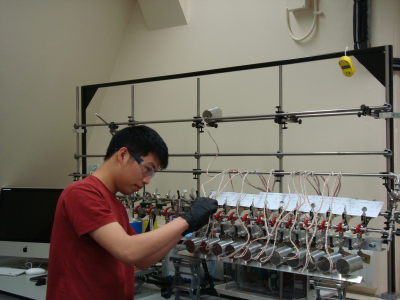Die Inhalte dieser Seite sind leider nicht auf Deutsch verfügbar.
Seitenpfad:
- Graduate School GLOMAR
- PhD student reports
- Research Placements
- Enqing Huang
Enqing Huang
Enqing Huang’s report on his research stay at the Department of Earth Sciences, University of Cambridge from 11 September – 10 November 2011
I am glad that I got this opportunity to visit this top-ranking university for two months. One of research topics in my Ph.D. program is to explore the deep ocean ventilation during the Last Glacial Maximum. This requires analyzing radiocarbon ages of planktonic and benthic foraminifera from deep-sea samples. My purpose of visiting Cambridge is to graphitize my carbonate samples there before they could be sent to accelerated mass spectrometry (AMS) 14C labs for final measurements.
I worked with Dr. Luke Skinner and spent most of my time in his radiocarbon laboratory. For the first time I learned the pre-treatment and preparation techniques of radiocarbon samples, as well as some critical problems with respect to the carbon isotope fractionation and radiocarbon measurements. We setup an experimental protocol to process my carbonate samples: after being weighed, crashed and cleaned, foraminiferal samples were subsequently digested by acid to produce carbon dioxide. In a vacuum pipe system, the carbon dioxide samples were further graphitized at a temperature of several hundred degrees.
My research benefited a lot from this visit. First, usually researchers are required to wait for a couple of months for radiocarbon results. However, as we finished the step of graphitization by ourselves, graphitized samples can be analyzed by the AMS 14C lab straightway. We can obtain the final results in a few weeks. Second, the cost of radiocarbon analyses is relatively high. Again as we did the graphitization step by ourselves, the cost for the analyses of each radiocarbon sample could be reduced by 1/3. This is especially important for my research, because I need to analyze a large number of samples, around 170 for my project. Third, some of my carbonate samples have a relatively smaller volume. In Cambridge these samples were carefully cleaned and processed. We hope that after a set of special treatments the error bars in the final results could be reduced.
I also enjoyed very much the academic environment in Cambridge. There are seminars and lectures nearly every day in the Department of Earth Sciences, discussing the cutting-edge research topics from different perspectives. Once I was set free from the laboratory jobs, I always would like to join some seminars that are relevant to my research or of interests to me. The Department of Earth Sciences in Cambridge has a long history. Some distinguished geologists had been working there. They accomplished some important achievements during their stay in Cambridge which pushed forward the development of Earth Sciences. Visiting the museum inside the Department made me learn more interesting stories and details about their work and life in Cambridge.
I thank GLOMAR very much for its support that makes this visit possible.
I worked with Dr. Luke Skinner and spent most of my time in his radiocarbon laboratory. For the first time I learned the pre-treatment and preparation techniques of radiocarbon samples, as well as some critical problems with respect to the carbon isotope fractionation and radiocarbon measurements. We setup an experimental protocol to process my carbonate samples: after being weighed, crashed and cleaned, foraminiferal samples were subsequently digested by acid to produce carbon dioxide. In a vacuum pipe system, the carbon dioxide samples were further graphitized at a temperature of several hundred degrees.
My research benefited a lot from this visit. First, usually researchers are required to wait for a couple of months for radiocarbon results. However, as we finished the step of graphitization by ourselves, graphitized samples can be analyzed by the AMS 14C lab straightway. We can obtain the final results in a few weeks. Second, the cost of radiocarbon analyses is relatively high. Again as we did the graphitization step by ourselves, the cost for the analyses of each radiocarbon sample could be reduced by 1/3. This is especially important for my research, because I need to analyze a large number of samples, around 170 for my project. Third, some of my carbonate samples have a relatively smaller volume. In Cambridge these samples were carefully cleaned and processed. We hope that after a set of special treatments the error bars in the final results could be reduced.
I also enjoyed very much the academic environment in Cambridge. There are seminars and lectures nearly every day in the Department of Earth Sciences, discussing the cutting-edge research topics from different perspectives. Once I was set free from the laboratory jobs, I always would like to join some seminars that are relevant to my research or of interests to me. The Department of Earth Sciences in Cambridge has a long history. Some distinguished geologists had been working there. They accomplished some important achievements during their stay in Cambridge which pushed forward the development of Earth Sciences. Visiting the museum inside the Department made me learn more interesting stories and details about their work and life in Cambridge.
I thank GLOMAR very much for its support that makes this visit possible.



